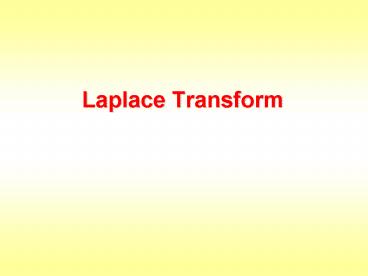Laplace Transform - PowerPoint PPT Presentation
1 / 29
Title:
Laplace Transform
Description:
Laplace Transform Formulas. 8. 7. s3F(s) - s2 f(0) - sf'(0) - f''(0) 6. s2F ... Other important formulas from LT. Initial value theorem : Final value theorem : ... – PowerPoint PPT presentation
Number of Views:129
Avg rating:3.0/5.0
Title: Laplace Transform
1
Laplace Transform
2
Definition
Let f(t) be a function defined for all t 0.
The Laplace transform of f is the function F(s)
defined by
(1)
provided the integral on the right exists.
The original function f(t) in (1) is called the
inverse transform or inverse of F(s) and is
denoted by L-1F, i.e.,
f(t) L-1F(s).
3
Notation Original functions are denoted by
lower case letters and their Laplace transforms
by the same letters in capitals. Thus F(s)
Lf(t), Y (s) Ly(t) etc.
By definition, for any function h defined on 0,
),
the integral is said to converge if this limit
exists. If this limit does not exist, the
integral is said to diverge and the integral does
not exist.
4
Laplace transform of elementary functions
Exponential function Let f(t) eat, when t 0,
where a is a constant. Find Lf.
Solution
LT
5
Unit step function
LT
6
Delayed unit step function
Shifted version of u(t)
LT
7
Function tn
Thus, using induction
LT
8
Sine and cosine function
From elementary calculus,
LT
9
From elementary calculus,
LT
10
Transform of derivatives and integrals
- Assuming that Lf (t) F(s) and given that
- f (t) is continuous for all t gt 0
- f (t) is of exponential order as
- f '(t) is piecewise continuous and of
exponential order.
Then, L f '(t) sF(s) f(0)
For integrals
Then
11
A table of Laplace Transforms
12
(No Transcript)
13
Laplace Transform Formulas
14
Examples
15
Find the LT of
From the table
Let (n-1) 2,
x 2
x 2
16
Inverse Laplace Transform
Inverse Laplace transform is used to transform
the s-domain solution back to the original domain
ie s to t
- The inverse Laplace transform, f(t) L-1F(s),
is obtained - from a table of transforms.
- Partial fractions expansion is used to help in
simplifying - complicated functions. We consider 3 basic cases
- where the denominator of F(s) contains
- only distinct linear factors
- repeated linear factors
- a quadratic factor.
17
- Denominator contains only distant linear factors
Evaluate
Let
Solution
Comparing the numerators
1 A(s 2)(s 4) B(s - 1)(s 4) C(s -
1)(s 2)
18
Setting s 1, 1 A(3)(5)
A 1/15
s -2, 1 B(-3)(2)
B -1/6
s -4, 1 C(-5)(-2)
C 1/10
Thus,
19
(ii) Denominator contains repeated linear factors
Evaluate
Solution Let
Comparing the numerators
s 1 As(s 2)3 B(s 2)3 Cs2(s
2)2 Ds2(s 2) Es2
20
B 1/8
Setting s 0
E -1/4
s -2
By equating coefficients of s4 0
A C s3 0 6A B 4C D s 1 8A
12B
A -1/16, C 1/16, D 0
21
Since
22
(iii) Denominator contains a quadratic factor
Evaluate
Solution Let
Comparing numerators,
3s - 2 As2(s2 4) Bs(s2 4) C(s2 4)
(Ds E)s3
Setting s 0
C -1/2
23
By equating the coefficients of
s4 0 A D s3 0 B E s2 0 4A
C s 3 4B
A 1/8, B 3/4, D -1/8, E -3/4
24
Example on DE
Solve the DE
where u(t) is the unit-step function. The initial
conditions are x(0) -1 and x'(0) 2.
Solution Take Laplace transform of the
individual terms
25
Substituting back into the original DE
Solution of DE in the s-domain
The solution in the original domain is
Solution of DE in the time domain
26
Use of LT in solving circuit problems
Find the voltage V0 across the capacitor,
assuming that R 1x106 W, C 1x10-6 F and Vi
5V. Assume initial conditions to be V0(0) 0 V
Original DE
27
Time domain DE
Denote
Taking LT on both sides of the DE
0
Solution of V0(t) in the s-domain
28
To go back to time domain, take the inverse LT of
V0(s) to get V0(t).
Therefore
DE solved easily using Laplace Transforms!
29
Other important formulas from LT
Initial value theorem
Final value theorem
For the RC circuit problem, apply final value
theorem to V0(s) to get the final value of V0(t).
Hence the final voltage across the capacitor is 5
V.

